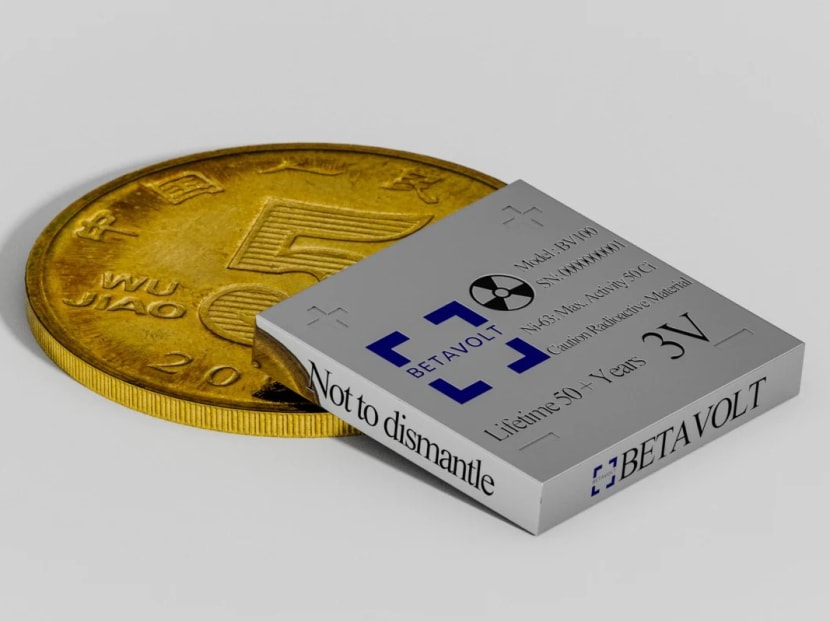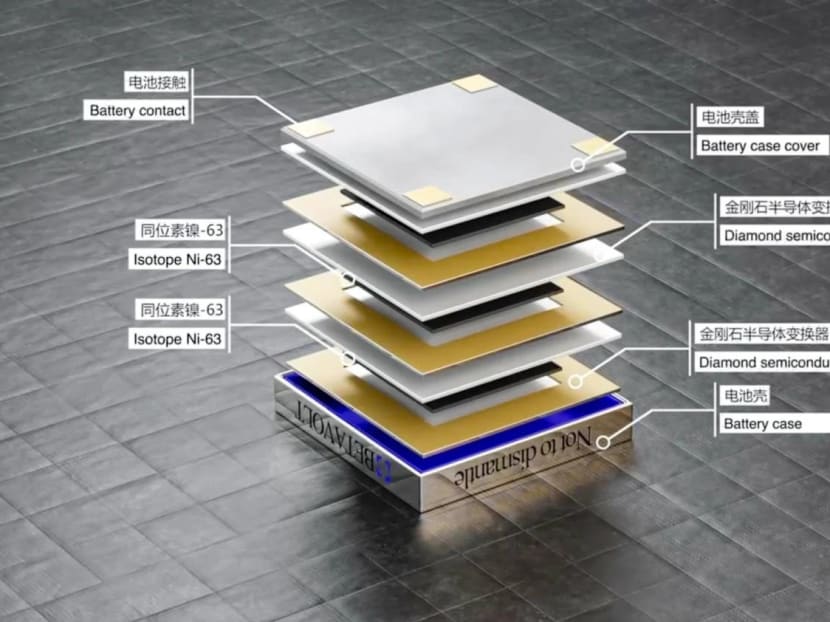
The good news is that it works well and is certainly a path to power generation that can be nicely driven down in price.
The bad news is that the method produces gamma rays also known as xrays. This is obviously small enough to get away with commercially.
That will not be true with a one watt unit..This does mean gamma ray shielding like a thin layer of lead. You get my point.
Yet lead is cheap and thus for large immobile applications, easily fitted. I also think that this can get cheap enough to allow market dominance. I just do not see us driving a slab of lead around too quickly.
Chinese-developed nuclear-powered battery can last 50 years without recharging
Handout via SCMP
The nuclear-powered BV100 can last decades and is safe to use in extreme conditions. It could go into mass production by the end of this year.
Published January 21, 2024
Updated January 21, 2024
WhatsAppTelegramFacebookTwitterEmailLinkedIn
https://www.todayonline.com/world/chinese-developed-nuclear-powered-battery-can-last-50-years-without-recharging-2345776
HONG KONG — A company in China has developed a battery that it says can last longer than the devices it powers. The nuclear-powered BV100 is smaller than a coin and can provide power for 50 years without the need for recharging, according to Beijing-based start-up Betavolt Technology, the company behind the product.
The prototype battery harnesses energy released by nuclear isotopes and uses semiconductors to convert that energy into electrical power, the company said.
“The battery could enable devices like smartphones to operate indefinitely without recharging or drones to fly without landing,” the company said on its website.
Aside from a lengthy lifespan, the battery is also said to perform well under extreme conditions.
“Unlike traditional batteries, this nuclear battery operates safely under extreme conditions, from temperatures of 120 to -60°C, and is resistant to punctures and gunfire without catching fire or exploding,” Science and Technology Daily said in an article on Jan 8.
In addition to general civilian use, such a battery could be used in military applications like continuously flying drones, or for deep-sea monitoring devices that require long-term power supplies under extreme conditions, according to industry experts.
The BV100 measures just 15 x 15 x 5mm, with a power output of 100 microwatts and 3 volts. The company said it planned to mass-produce the battery by the end of this year and introduce a 1 watt version next year.
The underlying principle of the nuclear batteries is isotope technology, first proposed in 1913 by British physicist Henry Moseley. It captures energy from the nuclear decay of radioactive elements.

Handout via SCMPThe inner structure of BV100. Betavolt Technology plans to have a 1 watt version ready for 2025.
Unlike nuclear fission or fusion, nuclear decay is a spontaneous process in which isotopes emit radiation, leading to more stable new atoms. Scientists encapsulate these isotopes, converting the energy emitted into usable electrical power.
The lifespan of a nuclear battery correlates with the half-life of the isotope used as its energy source. For instance, the half-life of nitrogen-16 is only 7.13 seconds, whereas potassium-40 is around 1.3 billion years. The BV100 uses nickel-63 as its radiation source, which has a half-life exceeding 100 years, ensuring it stays operational throughout its 50-year lifespan.
Different isotopes emit alpha or beta particles and gamma rays during decay. Different isotopic raw materials can yield a variety of routes to make nuclear batteries.
For instance, the nuclear battery on China’s Chang’e-3 lunar rover, launched in 2013, used a thermoelectric converter to harness the heat produced by alpha particles released by the decay of plutonium-238 to generate electricity. Nasa’s Curiosity Mars rover uses a similar technology.
The BV100 battery is classified as betavoltaic, and using semiconductor junctions, it generates an electric current directly from beta particles (electrons) emitted from a radioactive source. In this instance, the beta particles released during the decay of nickel-63 are irradiated on the diamond semiconductor to form an electric field and achieve electrical energy output when connected to the circuit.
To improve energy conversion efficiency, Betavolt’s researchers developed a unique single-crystal diamond semiconductor, using a boron-doped diamond as a substrate and a plasma chemical vapour deposition method to create the diamond semiconductor converter.
The company claimed to be the only firm in the world capable of doping and manufacturing large-scale diamond semiconductor materials, a key component in making nuclear batteries.
The BV100 uses a modular structure, sandwiching a 2-micrometre thick nickel-63 layer between two 10-micrometre thick diamond semiconductors, forming a power-generating unit. By connecting multiple such modules, researchers can configure power outputs ranging from a few microwatts to several watts.
“The battery’s energy conversion efficiency currently stands at 8.8 per cent, with potential improvements using higher purity nickel-63 radiation sources,” the company said on its website.
“Besides aviation applications, isotope batteries are also used in submarine navigation beacons, heart pacemakers, and deep-sea cables,” said Dr Zhang Shixu, an associate professor from the School of Nuclear Science and Technology at Lanzhou University in northwest China.
However, Dr Zhang said that designing nuclear batteries for small electronic devices like smartphones and drones had been challenging.
“Concerns include nuclear safety and control, radiation protection limiting battery performance, and radiation damage to semiconductors from the gamma rays accompanying beta radiation in betavoltaic batteries,” he said.
CityLabs, a company in the United States, has been developing betavoltaic batteries using tritium isotopes since 2010. Their nuclear batteries are not widely available to consumers and only supply electricity for low-power devices in the nanowatt to microwatt range and can be extended to milliwatts.
“Tritium is safer, since its radiation is easily blocked. Some pacemakers also use tritium as radiation sources. Even if it leaks, it can be quickly excreted from the body through human metabolism. By comparison, nickel-63, used in the BV100, emits stronger radiation,” Dr Zhang said.
The long lifespan of nuclear batteries also raises recycling concerns. “Currently, main use cases like aerospace and pacemakers do not necessitate recycling, but it’s a consideration for applications like polar deep-sea beacons,” Dr Zhang said.
“We plan to record and recycle each battery after we start to sell the product. Also the nickel-63 decays into non-radioactive copper-63, posing no pollution threat,” a Betavolt researcher said.
“Integrating multi-stage batteries often leads to efficiency losses, a key research area for scientists,” Dr Zhang said. He added that sourcing costly isotopes mostly through imports is crucial for manufacturing nuclear batteries. SCMP
Unlike nuclear fission or fusion, nuclear decay is a spontaneous process in which isotopes emit radiation, leading to more stable new atoms. Scientists encapsulate these isotopes, converting the energy emitted into usable electrical power.
The lifespan of a nuclear battery correlates with the half-life of the isotope used as its energy source. For instance, the half-life of nitrogen-16 is only 7.13 seconds, whereas potassium-40 is around 1.3 billion years. The BV100 uses nickel-63 as its radiation source, which has a half-life exceeding 100 years, ensuring it stays operational throughout its 50-year lifespan.
Different isotopes emit alpha or beta particles and gamma rays during decay. Different isotopic raw materials can yield a variety of routes to make nuclear batteries.
For instance, the nuclear battery on China’s Chang’e-3 lunar rover, launched in 2013, used a thermoelectric converter to harness the heat produced by alpha particles released by the decay of plutonium-238 to generate electricity. Nasa’s Curiosity Mars rover uses a similar technology.
The BV100 battery is classified as betavoltaic, and using semiconductor junctions, it generates an electric current directly from beta particles (electrons) emitted from a radioactive source. In this instance, the beta particles released during the decay of nickel-63 are irradiated on the diamond semiconductor to form an electric field and achieve electrical energy output when connected to the circuit.
To improve energy conversion efficiency, Betavolt’s researchers developed a unique single-crystal diamond semiconductor, using a boron-doped diamond as a substrate and a plasma chemical vapour deposition method to create the diamond semiconductor converter.
The company claimed to be the only firm in the world capable of doping and manufacturing large-scale diamond semiconductor materials, a key component in making nuclear batteries.
The BV100 uses a modular structure, sandwiching a 2-micrometre thick nickel-63 layer between two 10-micrometre thick diamond semiconductors, forming a power-generating unit. By connecting multiple such modules, researchers can configure power outputs ranging from a few microwatts to several watts.
“The battery’s energy conversion efficiency currently stands at 8.8 per cent, with potential improvements using higher purity nickel-63 radiation sources,” the company said on its website.
“Besides aviation applications, isotope batteries are also used in submarine navigation beacons, heart pacemakers, and deep-sea cables,” said Dr Zhang Shixu, an associate professor from the School of Nuclear Science and Technology at Lanzhou University in northwest China.
However, Dr Zhang said that designing nuclear batteries for small electronic devices like smartphones and drones had been challenging.
“Concerns include nuclear safety and control, radiation protection limiting battery performance, and radiation damage to semiconductors from the gamma rays accompanying beta radiation in betavoltaic batteries,” he said.
CityLabs, a company in the United States, has been developing betavoltaic batteries using tritium isotopes since 2010. Their nuclear batteries are not widely available to consumers and only supply electricity for low-power devices in the nanowatt to microwatt range and can be extended to milliwatts.
“Tritium is safer, since its radiation is easily blocked. Some pacemakers also use tritium as radiation sources. Even if it leaks, it can be quickly excreted from the body through human metabolism. By comparison, nickel-63, used in the BV100, emits stronger radiation,” Dr Zhang said.
The long lifespan of nuclear batteries also raises recycling concerns. “Currently, main use cases like aerospace and pacemakers do not necessitate recycling, but it’s a consideration for applications like polar deep-sea beacons,” Dr Zhang said.
“We plan to record and recycle each battery after we start to sell the product. Also the nickel-63 decays into non-radioactive copper-63, posing no pollution threat,” a Betavolt researcher said.
“Integrating multi-stage batteries often leads to efficiency losses, a key research area for scientists,” Dr Zhang said. He added that sourcing costly isotopes mostly through imports is crucial for manufacturing nuclear batteries. SCMP
No comments:
Post a Comment